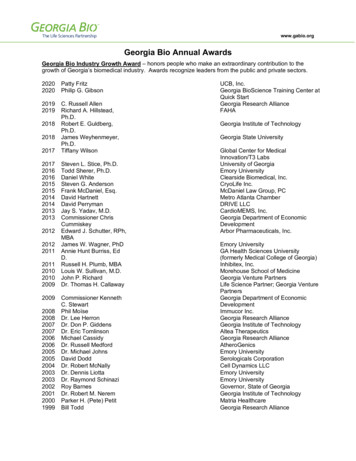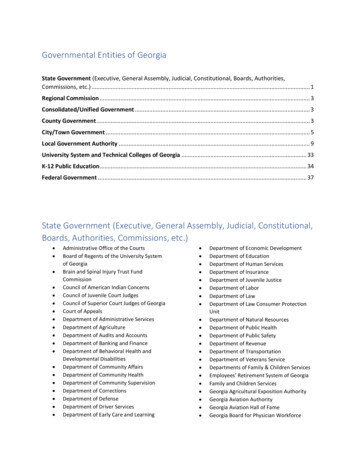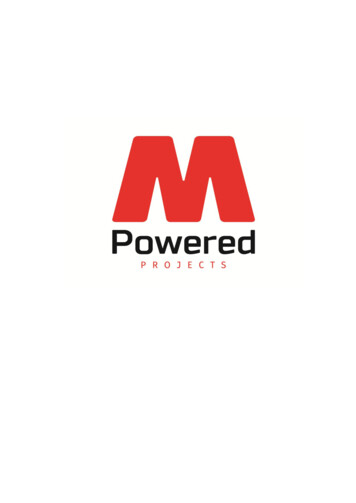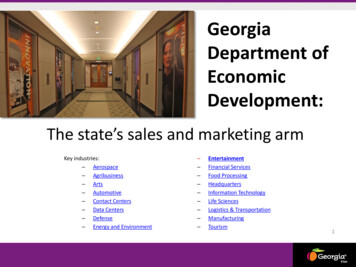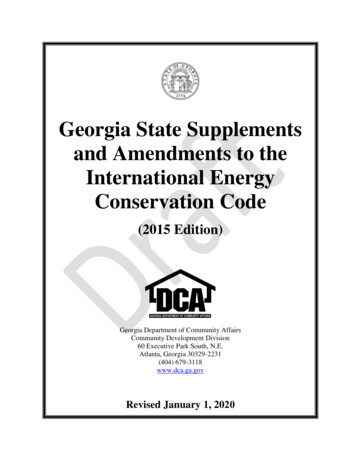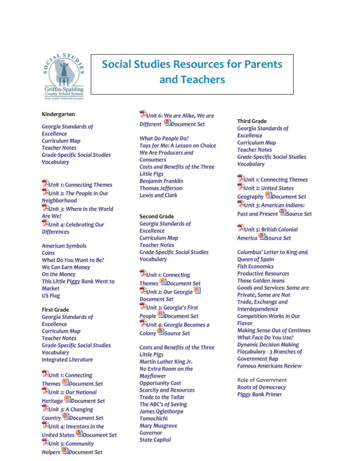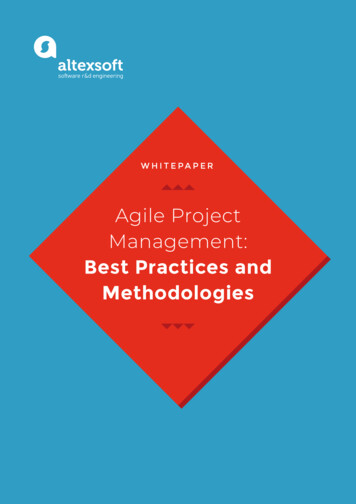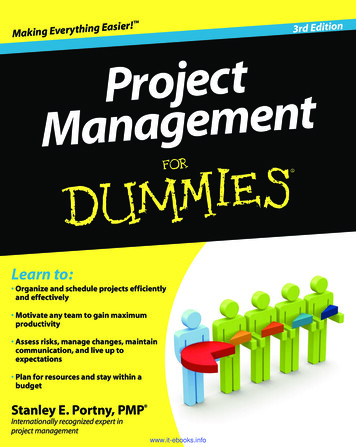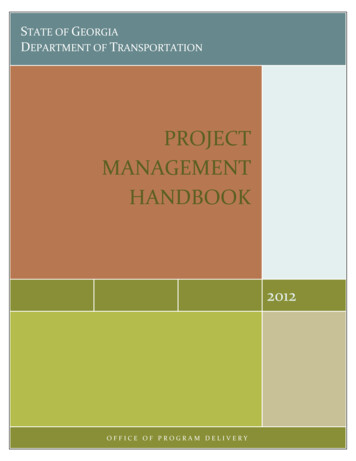
Transcription
StatSTATE OF GEORGIADEPARTMENT OF t Manager HandbookOFFICE OF PROGRAM DELIVERY
This document was developed as part of the continuing effort to provide guidance within the GeorgiaDepartment of Transportation in fulfilling its mission to provide a safe, efficient, and sustainabletransportation system through dedicated teamwork and responsible leadership supporting economicdevelopment, environmental sensitivity and improved quality of life. This document is not intended toestablish policy within the Department, but to provide guidance in adhering to the policies of theDepartment.Your comments, suggestions, and ideas for improvements are welcomed.Please send comments to:The Office of Program DeliveryGeorgia Department of TransportationOne Georgia Center600 W. Peachtree Street, 25th FloorAtlanta, Georgia 30308DISCLAIMERThe Georgia Department of Transportation maintains this printable PM Manual document and issolely responsible for ensuring that it is equivalent to the approved Department guidelines.2Project Manager Handbook
TABLE OF CONTENTSChapter 1.General OverviewChapter 2.Project Management DefinitionsChapter 3.Project Management OverviewChapter 4.SchedulesChapter 5.The Programs and Their BudgetsChapter 6.Consultants and InvoicingChapter 7.Legal MattersChapter 8.Project Team Initiation Process (PTIP)Chapter 9.Concept StageChapter 10.Preliminary DesignChapter 11.Final DesignChapter 12.Design Guideline Exceptions / VariancesChapter 13.ConstructionAppendix A. Project White PaperAppendix B. Internal Project Manager ExpectationsAppendix C.3Conference Rooms in the General OfficeProject Manager Handbook
CHAPTER 1GENERAL OVERVIEWThe purpose of the Project Manager Handbook is to serve as a guide and resource tool for GeorgiaDepartment of Transportation Project Managers.This Handbook is an addendum to the guidance found in the GDOT Policies and Procedures, the PlanDevelopment Process (PDP) and the Locally Administered Project Manual (LAP), in addition to other manuals.The PDP can be accessed by accessing the ROADS website under the Office of Policy and Support.The LAP can be accessed by accessing the external GDOT website and going to the Local Government tab.Other Project Manager Guidance:The GDOT internal website, http://mygdot.dot.ga.gov, has a variety of important links that give guidance onProject Manager activities.This Handbook will:1. Ensure that project objectives are achieved as programmed2. Guide the project team through the project delivery process3. Develop dynamic interaction between team members and stakeholders4. Identify, monitor and mitigate risks5. Strengthen communication throughout the project’s development6. Ensure continuity of project knowledge between phases through a single point of contact,documentation, reporting and communication7. Utilize management and project tools to ensure the project’s success4Project Manager Handbook
GDOT VISIONEnhancing Georgia’s Competitiveness Through Leadership in TransportationGDOT MISSIONGeorgia DOT provides a safe, connected and environmentally sensitive transportationsystem that enhances Georgia’s economic competitiveness by working efficiently andcommunicating effectively to create strong partnerships.GDOT VALUESFlexibleOpenCommittedUnifiedSuccessfulGDOT STRATEGIC GOALS Making GDOT a better place to work will make GDOT a place that works better. Making safety investments and improvements where the traveling public is most atrisk. Taking care of what we have, in the most efficient way possible Planning and constructing the best set of mobility focused projects we can, onschedule.PROGRAM DELIVERY – DELIVERING EXCELLENCETo provide Project Management, Leadership, and Organizational Commitment by applyingEngineering Principles and Coordinating Subject-Matter Expertise on the Construction WorkProgram by scoping projects, analyzing risk, identifying potential problems, definingsolutions, meeting task and resource requirements, meeting schedules, maintaining budgets,and establishing stakeholder relationships, to achieve a high-quality and dependableproduct.5Project Manager Handbook
OFFICE OF PROGRAM DELIVERY – GOALS AND OBJECTIVES1. Understand the role of the Project Manager along with vital and dynamic responsibilities.2. Complete all project tasks, contract phases and programmed projects within the budget.3. Ensure that the scope of work complies with the original intent and established Justification Statement.4. Foster and strengthen Team Building with Subject Matter Experts (SME’s).5. Enhance personal development through on-going training, seminars, and lectures.6. Update TPROWEB regularly with comments from SME’s and communicates the changes to provide teammembers and management with accurate information in a timely manner.7. Progressively improves the Project Delivery time through the efficient use of project managementtechniques, tracking tools and human resources.8. Prepare cost estimates annually (at a minimum) and update according to milestones achieved for thoseprojects funded in the CWP or with an active phase or if there is a major scope change.9. Maintain the currently approved baseline schedules and if necessary recover when necessary to keep theoverall project schedule accurate and online.10. Measure progress for each PM related to the following six major project milestones:a. Preliminary Engineering Authorizationb. Concept Report Approvalc. Preliminary Field Plan Review (PFPR)d. Environmental Document Approvale. Right of Way Authorizationf. Final Field Plan Review (FFPR)g. Construction Authorization11. Process and ensure approval of invoices within 30 calendar days of receipt.12. Maintain a project diary documenting major decisions, meeting minutes, issues and action items for SME’sand stakeholders associated with a chronological timeline.13. Aid Procurement in the Scoping and Negotiation Phases.14. Minimize the number of Project Change Requests, Change Orders, and Supplemental Agreements.15. Escalate important Project Management issues utilizing the office hierarchy for approval.16.Represent the Department in a positive manner in all situations.6Project Manager Handbook
OFFICE OF PROGRAM DELIVERY – ORGANIZATION AND ADMINISTRATIONThe Office of Program Delivery (OPD) was created in 2009 in the Georgia Department of Transportation tofacilitate the projects from “cradle to grave” using established Project Management practices.Administration Genetha Rice-Singleton, State Program Delivery Engineer (initials: GRS) Brad Saxon, Assistant State Program Delivery Engineer (initials: BWS) Albert Shelby, Assistant State Program Delivery Engineer (initials: AVS) Hiral Patel, P.E., Assistant State Program Delivery Engineer (initials: HPP) Organizational chart.pdfTHE PROGRAMThe GDOT Program includes all the projects in the Statewide Transportation Improvement Plan (STIP) and theConstruction Work Plan (CWP). The Program can be broken down into sub-programs, including:A.B.C.D.E.F.G.GDOT Administered ProjectsLocally Administered ProjectsTransportation Enhancement (TE) ProgramBridge Maintenance ProgramTraffic Operations and Safety ProgramsMaintenance ProgramSpecial Projects (Multi-Modal Passenger Terminal, High Speed Rail, Atlanta Beltline, etc.)Each of these programs has specific risks and challenges to delivery. Project Managers will be assignedprojects within these programs by the Administration of OPD. The Program is further discussed in Chapter 5.DELIVERY OF THE PROGRAMThe GDOT Project Manager ToolboxAs a GDOT project manager, the Department has a vested interest in providing you with the effective tools tocomplete the job. These tools consist of: Equipmento Communication devices such as cell phoneso Computer hardware and softwareo Office supplies On the Job training7Project Manager Handbook
EquipmentProgram Delivery is committed to providing Project Managers the equipment they need to do their jobs andhaving it ready for them upon arrival. It is important to have everything in place and ready to go beforeProject Managers arrive in order to convey that time is of the essence in Project Management. In order toachieve this Project Managers will have a desk, computer setup (or laptop), cell phone, and office phone readyupon their arrival.Project Managers in the General Office will use the Motor Pool for business trips to project sites and meetings,except for the ones in Area Offices who will use those facilities’ vehicles. The Motor Pool request form islocated online under Policies and Procedures form 7197-1. The Project Managers that will be in Area Officelocations will receive a laptop and cell phone and report to the General Office on an as needed basis. The desk assignment is done by the Assistant Office Head (AOH)The computer set-up will be facilitated by ITThe cell phone will be assigned by the AOHThe office phone set-up will be facilitated by ITA Project Manager also should receive the following: General office supplies Copies of the Plan Development Process (PDP); Local Administration Process (LAP) and PM Handbook A PM ledger book A safety vest and hat A mailbox assignment A parking assignment A GDOT badgeOnce a desktop or laptop computer has been assigned and set-up by the IT office, the following softwareshould be installed (at a minimum): Microsoft Office Suite (Outlook, Word, Powerpoint, etc.) TPROWeb & GEOTRAQS Work Force Time Keeper (WFTK) Microstation (latest version) Connections to plotters and printers in the office Plot Manager Submit Adobe Acrobat (latest version) Peoplesoft CONCUR Cost Estimating Software (CES) CMIS Google Earth Oracle PrimaveraA Project Manager should also request: A Peoplesoft password A CES password A CMIS password8Project Manager Handbook
On the Job TrainingBoth informal and formal training programs have been created to facilitate the skills and knowledge forsuccessful GDOT Project Management. We also encourage new employees to peruse the Policies andProcedures website. Here are a few key policies and procedures to review; one can search for these by keyword or policy number.Informal Project Manager training to be reviewed is as follows:General Policies 3A-1, Principles of Decision-making 3A-9, Project Programming & Cost Estimating Purpose 3D-1, Environmental Responsibility of the Georgia DOT 4020-1, Procurement, Contract Dev and Mngt of Professional Services for Architectural andEngineering Work 4020-4, Errors and Omissions 7120-1, Project Funding Policy (note, this policy is a little outdated)Human Resources/Administration Policies 2230-2 through 2230-12 Leave 2255-1 through 2255-11, various workplace policies 7195-1, 2 & 8, Travel Reimbursement 7197-1, Motor Pool Vehicle Request Policy 2215-22 Project Management – Conditional PayDesign-related policies 4A-3 & 4, Establishing Access Control 3140-1, Interchange Policy 2440-1, Field Plan Review Inspections (note, view the external Policies site for updated policy) 2450-1, Value Engineering 4055-1, Public Involvement GuidelinesROADS -Design Policies, Guidelines and Procedures A link to the ROADS website is near the bottom of the home webpage. You should look at:o GDOT Design Policy Manualo Manual of Quality standards for Consultant Serviceso GDOT Plan Development Process & Flowchartso Revisions to Programmed Costs, Asphalt/Fuel Indexes, Construction ContingenciesOther links on the homepage to check out: 1625 Preconstruction Status Reports (PSR) Procurement Requisition Form (PRF) Project Financial Report (PFR)9Project Manager Handbook
Also check out the links in the Favorites Folder GDOT Important LinksFormal Project Manager training will be conducted as follows:Conducted by the Assistant Office Heads during several sessions upon arrival of a new PM: GDOT Overview and Organizational Structure Desk, Computer, Blackberry, Parking Review Job Requirements PMFs and expectations Policy and Procedures Working Hours and Tele-work Procedures Leave Policy and Furloughs WFTK Training ELMS Training & Training Website GDOT Fact Book Office Supplies, Budget, and Car Pool Request Computer System and electronic filing Meet your Team Office Visitation General Questions Meet your Projects Project Manager Log Book General Questions TPROWEB / Primavera Training New Employee Orientation conducted by the Human Resources Office PDP Training conducted through the Training Office Subject Matter Expert Offices Rotation TrainingDocument, Document, DocumentPhysical FilingThe PM has the responsible charge to document the progression of the project and the approvals required inthe PDP process. Along with keeping an electronic record of these documents, the PM should establish aphysical filing system of important documents. Some ways to physically file documents for easy access arecabinets for half-size plans, hanging file folders, tube files for roll plots or tabbed notebooks. This allows forquick access to essential documents should upper management need them.Electronic FilingThe PM should follow the below established practice for setting up the electronic files in CDCommon:PROJECT MANAGER ELECTRONIC DOCUMENTATIONCDCommon is the server drive located Design\CDCommon CDcommon Administration Consultant Distribution List10Project Manager Handbook
Forms [for forms not available online (no letterhead, no annual cost updateforms, etc)]\Fax.doc\General Routing Slip.doc\Transmittal letter.doc Invoices Labels Leave Records [Locked Folder, accessible by management and administrativestaff] OPD Committees OPD Meeting Minutes & Agendas Org Chart Signatures Employee Folders [team spreadsheets, etc; NO PROJECT INFORMATION] MatthewsT ShelbyA OPD SOP’s [PM how-to’s]\Electronic File Structure.doc\Construction Matrix.doc PMDP Training Procurement Projects 1234567 2345678 Closed Out Projects[construction has been completed – be sure to Archive aswell] 3456789 To Be DeletedProject Electronic File Structure (Note that ProjectWise software will eventually replace thissystem) FOLDER Sub-folder or document in the file CDCommon\1234567\ PE (Preconstruction) Administration Contract Correspondence Email PM diary AOH – used by the AOH as a quick reference file Schedule Budget 1625 requests and approvals Cost Estimates11Project Manager Handbook
Project Financial Reports (PFRs) Project Management Agreements (PMAs) Concept Concept Team meeting documents Displays Reports Revisions (by date) Design Bridge CAiCE DGN Exceptions & Variances FFPR Geotechnical [scans of BFIs & Soil Surveys] L&D PFPR Plans PS&E package QC-QA Right of Way Special Provisions Survey Traffic Utilities VE Studies Environmental Environmental document Green sheet Permits PIOH - PHOH Photos Planning IJRs - IMRs Logical Termini Justification Statement CST (construction) Administration Contract Correspondence Email PM diary Proposal (proposal/CST contract) Schedule Budget Claims12Project Manager Handbook
Force Accounts Supplemental Agreements Use on Construction Revisions Utilities*CorrespondenceRecommended file naming convention:type year/month/day (sorts better that way)trans 091218 recipient subjectltr 091218 recipient subjectfax 091218 recipient subjectinter 091218 recipient subjectmemo 091218 recipient subjectOnce the PM has completed the training, been assigned projects and created a filing system; the next step isgetting to know your projects. The Project White Paper template can be used to start tracking the status ofyour projects and where they are in the PDP process (see Appendix A).Reporting on ProjectsThe Department’s reporting software is TPROWEB. There are several fields that are required to be filled outby the Project Manager. The data in these fields shows up on the Preconstruction Status Reports that UpperManagement uses to make critical decisions on the projects.These fields include Schedule activity actual begin and end dates; Design field comments; District fieldcomments, and Expanded description field among others.Additionally, the PM is responsible for reporting on the project status at the District Quarterly Meetings and atLet Status.For Let Status the reporting procedure is as follows:Insert comments into the PDF of the Preconstruction Status Report If an item is completed include the date it was completed. If an item will be completed by the scheduled date then include “on schedule” and will bereceived/held/submitted by XXXXXX (date). If an item is behind schedule include reason for the delay and if it will be recoverable.13Project Manager Handbook
Baseline on schedule: yes or noFFPR:FFPR Response:Corrected Final Plans & estimate (18 weeks submittals):Final Plans:Utility:ROW:Environmental:Construction Authorization:Plans for reproduction:On schedule for let?*Project issue: submit updated issue log for each outstanding issueEscalation of problems that PMs encounter when delivering projects:The Project Manager is the first line of defense for keeping the project within scope, on schedule and withinbudget parameters. Should a procedural question or problem arise on a project, the PM should escalate tothe Senior Project Manager mentor assigned to them. If the project problem requires a decision from UpperManagement, the second tier of escalation should be addressed to the Assistant Office Head (AOH) assignedto the Sub-Program / District that the project is in. The AOH will determine the next course of action withinput from the PM.For internal non-responsiveness, the PM should escalate after 2 weeks of no response to the AOH. After 2additional weeks, the AOH should escalate to the Office Head to contact the counterpart Office Head.14Project Manager Handbook
CHAPTER TWOPROGRAM DELIVERY TERMS AND DEFINITIONSNOTE: Chapter 2 of the Plan Development Process is the definitive guide for definitions. This list is forreference only, the PDP takes priority if there is a conflict.Authorization of a Project - The process by which funds are approved for various stages of a project'sdevelopment, such as design, right-of-way purchase, or construction.Budget- a summary or list of all planned expenses and revenues. Budgeted cost of work performed measuresthe budgeted cost of work that has actually been performed, rather than the cost of work scheduled.Budgeted cost of work scheduled is the approved budget that has been allocated to complete scheduled tasksduring a specific time period.Concept – A consensus beginning recommendation, idea, or starting point of a transportation solution to anidentified transportation need. The objective of the concept stage is to develop a concept report that willdescribe and recommend project footprint, including logical termini.Construction Work Program - A listing of State and Federally funded projects approved by the TransportationBoard with one or more elements, Scoping, Preliminary Engineering, Right-of-Way Acquisition, orConstruction, scheduled in the current and next nine (9) years fiscal years.Construction - building or assembling of infrastructure. Far from being a single activity, large scale constructionis a feat of multi-tasking.Design Phase Leader – The individual charged with the coordination and timely delivery of a particular designphase.Earned Value is a project management technique for measuring project progress in an objective manner, witha combination of measuring scope, schedule, and cost in a single integrated system. Event chain methodologyis an uncertainty modeling and schedule network analysis technique that is focused on identifying andmanaging events and event chains that affect project schedules.Exempt Projects – A Federal aid project that is not subject to FHWA design oversight. Exempt projects as usedin this document, unless otherwise noted, do not
Chapter 13. Construction . Appendix A. Project White Paper . . o Computer hardware and software o Office supplies On the Job training . 8 Project Manager Handbook Equipment . Cost Estimating Software (C
